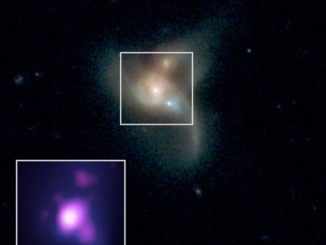
The other coloured dots are galaxies that host black holes emitting lower-energy X-rays, and were spotted by NASA’s Chandra X-ray Observatory. Chandra data show X-rays with energies between 0.5 to 7 kiloelectron volts, while NuSTAR data show X-rays between 8 to 24 kiloelectron volts. Image credit: NASA/JPL-Caltech.
To date, NASA’s Chandra mission has managed to pinpoint many of the individual black holes contributing to the X-ray background, but the ones that let out high-energy X-rays — those with the highest-pitched “voices” — have remained elusive.
New data from NASA’s Nuclear Spectroscopic Telescope Array, or NuSTAR, has, for the first time, begun to pinpoint large numbers of the black holes sending out the high-energy X-rays. More technically, NuSTAR has made significant progress in resolving the high-energy X-ray background.
“We’ve gone from resolving just 2 percent of the high-energy X-ray background to 35 percent,” says Fiona Harrison, Benjamin M. Rosen Professor of Physics and Astronomy at Caltech, the principal investigator of NuSTAR, and lead author of a new study describing the findings in an upcoming issue of The Astrophysical Journal. “We can see the most obscured black holes, hidden in thick gas and dust.”
The results will ultimately help astronomers understand how the growth patterns of supermassive black holes change over time — a key factor in the development of black holes and the galaxies that host them. For instance, the supermassive black hole at the centre of our Milky Way galaxy is dormant now, but at some point in the past, it would have siphoned gas and bulked up in size.
As black holes grow, their intense gravity pulls matter toward them. The matter heats up to extremely high temperatures and particles get boosted to close to the speed of light. Together, these processes make the black hole surroundings glow with X-rays. A supermassive black hole with an ample supply of fuel, or gas, will give off more high-energy X-rays.
“Before NuSTAR, the X-ray background in high-energies was just one blur with no resolved sources,” says Harrison. “To untangle what’s going on, you have to pinpoint and count up the individual sources of the X-rays.”
“We knew this cosmic choir had a strong high-pitched component, but we still don’t know if it comes from a lot of smaller, quiet singers, or a few with loud voices,” says coauthor Daniel Stern, the project scientist for NuSTAR at JPL. “Now, thanks to NuSTAR, we’re gaining a better understanding of the black holes and starting to address these questions.”
High-energy X-rays can reveal what lies around the most obscured supermassive black holes, which are otherwise hard to see. In the same way that medical X-rays can travel through your skin to reveal pictures of bones, NuSTAR can see through the gas and dust around black holes, to get a deeper view of what is going on inside.
With NuSTAR’s more complete picture of supermassive black hole populations, astronomers can begin to puzzle together how these objects evolve and change over time. When did they start and stop growing? What is the distribution of the gas and dust that both feed and hide the black holes?
The team expects that over time, NuSTAR will be able to resolve more of the high-energy X-ray background — and better decipher the X-ray song of the universe’s black holes.



